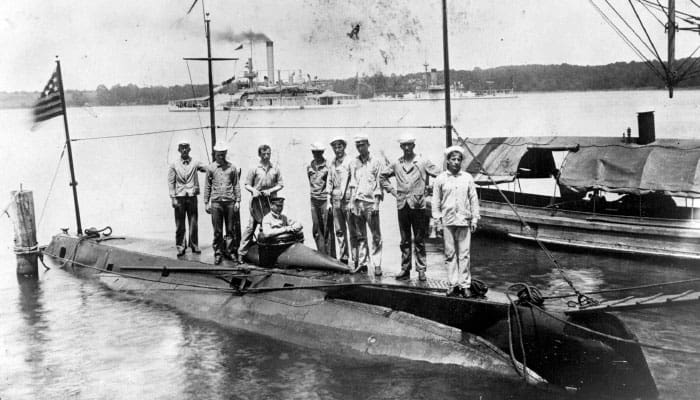Off the beaten North Fork path, New Suffolk is a quiet waterfront community tucked against Little Peconic Bay a few miles south of the Main Road in Cutchogue. Sun worshippers and swimmers gather at the local beach and kayaks, paddleboards and sailboats fill the bay waters. At the intersection of First and Main Streets, a large metal marker looms over a spit of beach and Cutchogue Harbor, the only remaining marker of New Suffolk’s vital role in US Naval History.
The US Civil War naval battle between the Monitor and the Merrimack sets the backdrop: the first battle in history between ironclad warships, it heralded the end of the wooden fleets and the rise of ironclad navies. John Philip Holland, an Irishman from Cork, understood the momentous nature of this battle from the unique perspective of an Irish patriot: iron shipbuilding would render the British fleet invincible, thus preventing Ireland from achieving freedom from British rule. With visions of thwarting British naval supremacy, Holland began designs for a self-propelled submarine; by the time he emigrated to America in 1872, he had worked out most of the operating principles.

Settling in New Jersey, Holland continued work on his plans. He brought his novel designs – a far cry from the hand-cranked subs used to limited success in the US Civil War as well as the Napoleonic Wars – to the Secretary of the Navy. The Navy declined to participate in the venture. The American arm of the Irish Republican Brotherhood (known as the “Fenians”) saw opportunity and funded the development of Holland’s first two operational submarines. The first sunk amid jeers in 1878; the second was successfully launched in 1881, a 30 foot elliptical craft propelled by a combustion engine and nicknamed the “Fenian Ram.”
Through most of the next two decades, Holland continued to upgrade his designs and build prototype subs – none of which were ever commissioned by the Navy until his sixth design, the “Holland” in 1897. 53 feet long carrying a crew of five, the Holland had a dual power system (gas powered engine for surface, electric battery for submersion) and a torpedo tube. Needing additional funding to implement a major design change (moving the rudders behind the propeller for ease of steering), Holland sold his interest in the Holland Torpedo Boat Company in 1898 to Isaac Rice, owner of the Electric Boat Company. The redesigned sub underwent testing in New York Harbor; while the seas were calm enough, shipping traffic, safety concerns, nosy onlookers and foreign spies deterred proper trials. In spring of 1899, Holland and Rice moved the sub and all operations to New Suffolk, leasing the Goldsmith and Tuttle shipyard for $10 per month.
Submarine trials continued through the rest of 1899 within a three-mile course plotted in Cutchogue Harbor and Peconic Bay. Naval officers, US Senators and VIP’s were taken on demonstration runs, including Red Cross founder Clara Barton – who reportedly scolded Holland for creating a “deadly instrument of war.” On April 11, 1900 – considered to be the founding date of the U.S. Submarine Force – the Navy purchased the Holland for $150,000. The USS Holland (SS-1) was put into service on October 12, 1900 as the first commissioned submarine in US Naval history. Subsequently, the Navy ordered six additional Holland-type submarines, all of which underwent trials at the submarine base in New Suffolk, known as the “Holland Torpedo Boat Station”. The base remained in operation from 1899 through 1905, when Electric Boat Company moved to Groton, Connecticut. Electric Boat is still in existence, building nuclear subs as a part of General Dynamics.
As for John Philip Holland — he earned the nickname “Father of Modern Submarines.” Many later submarines were based on the original Holland design: including the elliptical shape, his dual power design was adapted for US nuclear submarines; facets of his designs were also used in English, German, Russian and Japanese submarines.






